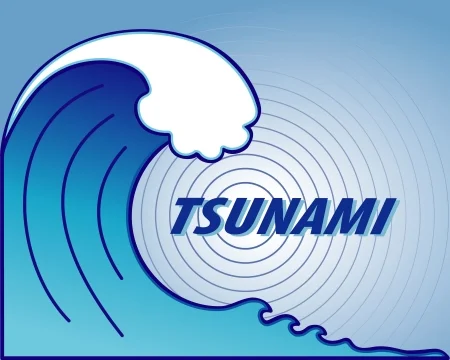
Tsunami is a Japanese word with the English translation, “harbor wave.” Represented by two characters, the top character, “tsu,” means harbor, while the bottom character, “nami,” means “wave.” In the past, tsunamis were sometimes referred to as “tidal waves” by the general public, and as “seismic sea waves” by the scientific community. The term “tidal wave” is a misnomer; although a tsunami’s impact upon a coastline is dependent upon the tidal level at the time a tsunami strikes, tsunamis are unrelated to the tides. Tides result from the imbalanced, extraterrestrial, gravitational influences of the moon, sun, and planets. The term “seismic sea wave” is also misleading. “Seismic” implies an earthquake-related generation mechanism, but a tsunami can also be caused by a nonseismic event, such as a landslide or meteorite impact.
Tsunamis are formed from earthquakes. Earthquakes can occur when two plates in the earth’s crust collide. The earthquake causes the seabed to move quickly and water is displaced causing waves. The half meter waves are out at sea. They travel at extraordinary speeds of 800 km/h. the waves, at this stage are hardly noticeable on the surface of the ocean. The waves slow down to about 300 km/h as the water becomes shallower. The waves then become closer together and only seconds between them. The waves become really tall as they reach the shore and pile onto one another. They can reach amazing heights of up to 35 meters. As they hit the land they engulf everything then suck the debris back into the ocean.
On the 27th of August, 1883 Krakatoo a volcanic island in Indonesia erupted producing a tsunami 35 meters high it traveled at 550 km/h destroying coastal communities in Java and Sumatra and killing more than 30, 000 people about 90% of tsunamis occur in the Pacific ocean. Tsunamis are quiet rare in the Atlantic ocean. The most active tsunamis are along the coast of Peru and Chile. Tsunamis are said to occur there once every two years * on the 17th of July, 1998. Three tsunami waves hit the west east coast of Papua New Guinea, near the town of Aitape and wiped out entire communities along a 30 km stretch of land. It was caused by two under sea earthquakes, measuring 7. 0 on the Richter scale. By the time the waves hit the shore line they reached a height of 10 meters. The communities had no warning and nowhere to go. Over 2, 000 people were killed many of them children. The few villagers who survived had lost everything * on the 21st and 22nd of May, 1960 almost 50 earthquakes produced a series of tsunamis. Which killed 2, 500 people and caused damage in Japan, New Zealand Hawaii. The first three waves killed 1, 700 people in Chili. When the waves hit Hilo, Hawaii 61 people were killed.
It is very difficult to predict tsunamis because the earthquake that causes them may occur underwater far away and the shock waves may not be felt on the land. if you are at a beach there is a way of telling a tsunami is coming. You might not have much time but when you see the water slowly draining away into the ocean I advise you to run. The water being drained away contributes to the giant wave that’s just about to hit.
Credit : Slidetodoc
Picture Credit : Google




